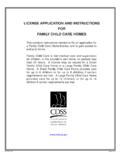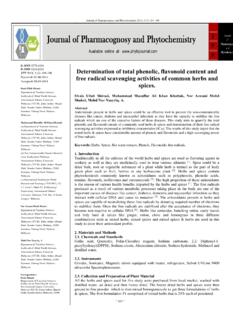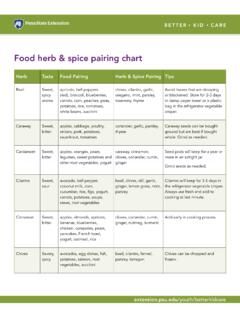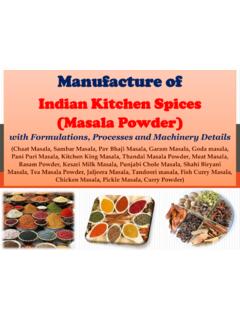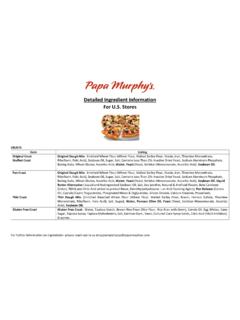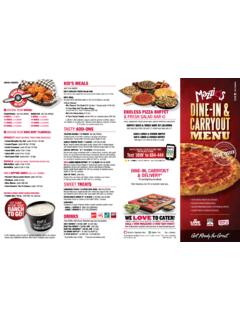Transcription of Cultural Considerations in Nutrition and Food Preparation
1 IHSS Training Academy 1 Cultural Considerations in Nutrition and Food Preparation It is important to understand Cultural differences in order to provide the best care to the consumer regardless of race, origin, gender, age, religion, sexual orientation, social class, economic situation, and/or disability. The varied diets and eating patterns of different cultures may impact your work as a provider during shopping and errands, meal prep, and eating. You cannot assume that your past experiences with a person from a particular culture can be applied to everyone from that culture. It is important to seek more information by asking your consumer questions about his/her culture and what kinds of foods he/she may prefer to eat and at what time of the day he/she prefers to eat a large meal.
2 These foods and meals may be different from what you are used to eating. Communicating with your consumer about his/her needs and how to shop for and prepare enjoyable food during the authorized hours will help to keep your consumer healthy and happy. A Few Common Diets: Mediterranean and Middle Eastern: At the base of this pyramid are all of the plant based foods as the foundation of the meal. Whole grains (including barley, bulgur, faro, rice, polenta couscous, and pastas), fruits, vegetables, beans, nuts and seeds, and legumes provide are healthy choices. Vegetables are normally cooked and drizzled with olive oil. herbs and spices are included in this section to improve taste.
3 Olive oil replaces other fats and oils, including butter and margarine, as the principal fat. Fish and shellfish several times a week provide the healthy fat omega-3. Tuna, herring, salmon, or shrimp would typically be grilled, broiled, or poached instead of battered or fried. Cheeses and yogurts are regular selections and low-fat options can be included daily. Eggs and poultry are recommended a couple times a week and other meat options and sweets less often. Drinking water is important and 1-2 glasses of wine a day can be included if appropriate. Fresh fruit is the typical daily dessert, with sweets with a significant amount of sugar and saturated fat consumed only a few times per week.
4 IHSS Training Academy 2 Mediterranean Foods Grains barley, buckwheat, bulgur, farro, millet, oats, polenta, rice, wheatberries, breads (pita), couscous, pastas Vegetables artichokes, arugula, beets, broccoli, brussel sprouts, cabbage, carrots, celery, celeriac, chicory, collard greens, cucumbers, dandelion greens, eggplant, fennel, kale, leeks, lemons, lettuce, mache, mushrooms, mustard greens, nettles, okra, onions (red, sweet, white), peas, peppers, potatoes, pumpkin, purslane, radishes, rutabaga, scallions, shallots, spinach, sweet potatoes, turnips, zucchini. Fruits apples, apricots, avocados, cherries, clementines, dates, figs, grapefruits, grapes, melons, nectarines, olives, oranges, peaches, pears, pomegranates, strawberries, tangerines, tomatoes.
5 Nuts, Seeds, Legumes almonds, cannellini beans, chickpeas, cashews, fava beans, green beans, hazelnuts, kidney beans, lentils, pine nuts, pistachios, sesame seeds, split peas, tahini sauce, walnuts. herbs and spices aleppo pepper, anise, basil, bay leaf, chiles, cloves, cumin, fennel, garlic, lavender, marjoram, mint, oregano, parsley, pepper, rosemary, sage, savory, sumac, tarragon, thyme, zatar. Fish & Seafood abalone, clams, cockles, crab, eel, flounder, lobster mackerel, mussels, octopus, oysters, salmon, sardines, sea bass, shrimp, squid, tilapia, tuna, whelk, yellowtail. Poultry, Eggs, Cheese, & Yogurt brie, chevre, corvo, feta, haloumi, manchego, Parmigiano-Reggiano, pecorino, ricotta, yogurt (including Greek yogurt), eggs (chicken, quail, duck), chicken, guinea fowl Meats and Sweets beef, duck, goat, lamb, mutton, pork, sweets (baklava, sigara boregi, stuffed dates, yogurt with fruit and honey) IHSS Training Academy 3 Mediterranean and Middle Eastern food pyramid: IHSS Training Academy 4 Asian: Each Asian region has its own distinct cooking styles and flavors but share some common foods.
6 Rice provides a basis for most Asian diets as do other grains such as noodles, millet, and corn. These along with fruits, vegetables, legumes, seeds, nuts, and vegetable oils make up most daily meal and snack selections. Diets overall are largely plant-based; animal sources of protein like fish and shellfish are common in areas with extensive coastlines, as is dairy in countries like India. Poultry, eggs, and sweets are more popular in some areas compared to others but are recommended for weekly consumption. Other meat sources, such as beef, are only consumed on an infrequent basis and are often combined with vegetables in dishes. Six to eight glasses of water or tea is recommended.
7 Sake, wine, or beers are also included in Asian eating but moderation is recommended. Asian Foods Grains barley, breads (dumplings, mantou, naan, and roti), buckwheat, rice, millet, noodles (soba, ramen, rice, udon) Vegetables bamboo shoots, bean sprouts, bitter melon, bok choy, broccoli, cabbage, carrots, chiles, daikon, eggplant, kumquats, leeks, lemons, lotus root, kale, kombu, mushrooms, mustard greens, peppers, pineapple, pumpkin, scallions, seaweed, snow peas, spinach, sweet potatoes, taro root, turnips, water chestnuts Fruits apricots, bananas, cherries, coconut, dates, dragon fruit, lychee, mandarins, mangoes, melon, milk fruit, oranges, pears, tangerines Nuts, Seeds, Legumes almonds, beans (adzuki, edamame, mung)
8 , cashews, hazelnuts, lentils, miso, peanuts, sesame seeds, tofu herbs and spices amchoor, basil (Thai), cardamom, chiles, clove, coriander, curry leaves, garlic, ginger, ginseng, kafir lime leaves, lemongrass masala, mint, parsley, pepper, scallion, star anise, turmeric, wasabi Fish & Seafood abalone, clams, cockles, crab, eel, king fish, mussels, octopus, oysters, roe, scallops, sea bass, shrimp, squid, tuna, whelk, yellowtail Poultry, Eggs, chicken, duck, eggs (chicken, duck, quail), IHSS Training Academy 5 Asian food pyramid: Cheese, & Yogurt cheeses and butter (ghee, paneer), yogurt (chaas, lassi) Meats and Sweets Pork, beef, lamb organs, sweets (Chinese mooncakes, Indian rice pudding, Japanese sugared sweet potatoes, Thai mango-coconut pudding) IHSS Training Academy 6 Latino: Latinos, those who trace their ancestry to Cuba, Mexico, Puerto Rico, or Central and South America, are the fastest growing group in the United States.
9 Plant based foods such as fruits, vegetables, whole grain corn, rice, beans, and nuts are recognized as the base of the diet. The Latin American diet includes fish, shellfish, plant oils, dairy, and poultry choices on a daily basis with other meats, eggs, and sweets only selected on a weekly basis. Water is also recommended and alcohol intake is recognized but encouraged only in moderation. Latin Foods Grains arepas, amaranth, breads, maize/corn, pasta, quinoa, rice, tortillas Vegetables Cabbage, carrots, cassava, chard, chayote, chiles, eggplant, garlic, jicama, kale, lettuce, maize/corn, nopales, peppers, potatoes, pumpkin, onion, okra, spinach, yams, yucca, zucchini Fruits acai, agave, avocados, bananas, breadfruit, cacoa, coconut, custard apples, grapefruit, guanabana, guava, lemons, limes, mangoes, melons, oranges, papayas, passion fruit, pineapple, plantains, pomegranate, prickly pear, pumpkin, quince, sapodilla, starfruit, sugarcane, tamarind, tangerine, tomatoes, tomatillos Nuts, Seeds, Legumes almonds, brazil nuts.
10 Beans (black, garbanzo, kidney, pinto), cashews, peanuts, pine nuts, pecans, pumpkin seeds (pepitas) herbs and spices chiles (aji, cayenne, jalapeno, habanero, pasilla, poblano, serrano), cilantro, cinnamon, epazote, garlic, oregano, parsley Fish & Seafood abalone, clams, cod, conch, crab, crayfish, mussels, octopus, sea bass, scallops, shrimp, squid, whelk Poultry, Eggs, Cheese, & Yogurt chicken, duck, geese, guinea fowl, squab, turkey, eggs (chicken, quail, duck), cheeses (asadero, cojita, minas, reggianito), yogurt, crema, milk Meats and Sweets beef, goat, lamb, pork, sweets (cakes, candy, chocolate, cookies, flan) IHSS Training Academy 7 Latin food pyramid: Adapted from Ethnic/ Cultural Food Pyramids, and Images used with permission from Oldways: Health Through Heritage, retrieved from , October 2013.




